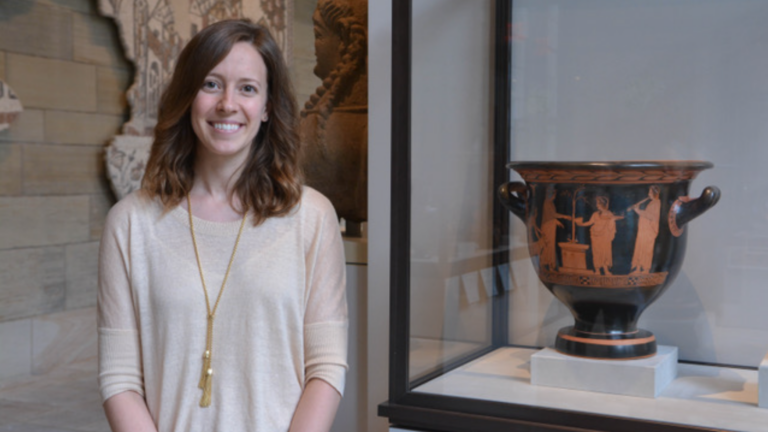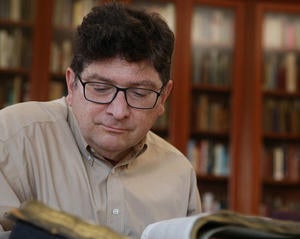CPW’s Conspiracy Project Continues
Conspiracies both real and imagined—truthfully, mainly imagined—continue to shape the culture and politics of our world, certainly to an unhealthy degree, but is it unprecedented? For the past three years, the Center for the Premodern World has investigated that question. In the summer of 2023, through the generosity of the Albert and Elaine Borchard Foundation, CPW arranged a symposium in a château in Brittany to examine the roles played by conspiracies and conspiracy theories in the medieval world. Our goals were not only to understand the historical impact of conspiratorial thought in the Middle Ages but also to ask what conditions enable such a world view to take hold.
On June 25, 2023, an international group of twelve scholars gathered at the Château de la Bretesche for a three-day symposium to discuss this question: the spread of conspiratorial thought in the Middle Ages. We took as our starting point the eleventh century, when an instinct to persecute heretics and Jews emerged. Heretics were rumored to be actively trying to undermine Christian belief, and Jews in France were accused of conspiring with Muslims in Egypt to try to destroy the Church of the Holy Sepulcher in Jerusalem. This tendency toward conspiratorial thought coincided with the advent of what R. I. Moore has famously defined as a “persecuting society.” Indeed, Moore himself was present for the symposium and noted the conceptual similarities between “conspiracy” and “heresy.” In the minds of medieval Inquisitors, the heresy they called “Catharism” seemed to be a vast, international conspiracy in which anti-Christian forces, goaded by missionaries (or propagandists?) from eastern Europe, spread doctrines that had the potential to destabilize Western society. Or were these accused Cathars heretics the creation of the Inquisitors themselves. Was the panic inspired by their secret meetings and subversive doctrines a sort of conspiracy propagated by Inquisitors?
Whatever the case, a belief in widespread conspiracies, fomented by heretics or Jews or Muslims or demons or lizard-men, took hold in Europe in the thirteenth century and reached something of an apogee during the rule of Philip IV “the Fair” of France (r. 1285-1314). It was Philip who famously turned the tools of Inquisition against the Knights Templar, an order founded to defend Latin Christian pilgrims and settlers in the Middle East during the crusades but who were accused by Philip of being in league with Muslims and of being devil worshippers. Philip’s reign may have represented the high point of conspiratorial thought, but it was by no means the end of it. Anti-Judaic conspiracy theories—blood libel and well poisonings, among others)—became habits of thought even as the world transitioned from the Middle Ages into Renaissance.
These were some of the topics and questions considered at the “Conspiracy and Conspiracy Theories” symposium. CPW hopes to continue to investigate this theme, especially since it remains stubbornly relevant. Why do we tell ourselves the stories that we do, and why do we continue to believe them and despite all evidence to take them in newer, stranger directions? The medieval world did not have a monopoly on irrational, supernatural terrors. Truth be told, no one in the Middle Ages believed that lizard men were conspiring against Western Civilization. That’s a twenty-first century conspiracy.
Participants at the symposium were: Christine Caldwell Ames (University of South Carolina), Tzafrir Barzilay (Bar-Ilan University), Elizabeth A. R. Brown (CUNY-Brooklyn), Dallas Denery (Bowdoin College), Sara Lipton (Stony Brook University), Helen Nicholson (Cardiff University), R. I. Moore (Newcastle University), Mark Pegg (Washington University in St. Louis), Gian Luca Potestà (Università Cattolica del S. Cuore, Milan), Jay Rubenstein (University of Southern California), Sophia Schmitt (University of Munich), and Julien Théry (l’Université Lyon II Louis Lumière).
The Albert and Elaine Borchard Foundation, which funded this event, has as its mission to promote research, education, social justice, and the arts and to improve the human condition. CPW is enormously grateful to the Borchard Foundation not only for providing the resources essential to making this event happen, but also for opening up such a beautiful and historically evocative space for our discussions.


Laura Smoller, CPW, Astrology, and the Huntington
This past February, Professor Laura Ackerman Smoller of the history department at the University of Rochester—an expert on topics as diverse as astrology, saints’ lives, prophecy, and the history of science—spent three days visiting USC’s Center for the Premodern World. On Tuesday February 9, she delivered a public lecture entitled, “Star-Gazers from the Mount of Victory: The Magi and Astrology in the Later Middle Ages.” In the lecture, Professor Smoller examined medieval interpretations of one of the Bible’s most popular stories: how the Wise Men from the East paid homage to the infant Christ. No one knew exactly who the Wise Men were, but one tradition held them to be astrologers from the Persian court. Astrology had long been an edgy subject in medieval Europe, famously condemned by St. Augustine of Hippo (354-430). As Latin intellectuals grew increasingly familiar with Greek and Arabic texts in the later Middle Ages, however, the theory that the Magi were astrologers to whom God revealed divine truths through changes in the heavens seemed ever more likely. That possibility in turn led to a renewed, serious interest in the study of astrology.

On the following day, Professor Smoller traveled with a small group of CPW-affiliated students to visit the Huntington Library to meet with Dr. Joel Klein, the Molina Curator for the History of Medicine and Allied Sciences at the Huntington. Dr. Klein, Professor Smoller, and CPW undergraduates John Ackerman (now at the University of Oxford), Hannah Brecher (now at the University of Cambridge) and Wendy Wang (happily still at USC) were able to examine manuscripts and early printed books related to the topics of prophecy and astrological speculation. And because we at CPW are not just interested in really old things, we also spent some time looking at a gargantuan original printing of Audobon’s Birds of America. Many thanks to Laura Smoller and Joel Klein for providing us with such a memorable day.

Past News
New Book from CPW Faculty
Congratulations to CPW affiliated faculty member Melissa Miller on the publication of her new book
Mind, Motivation, and Meaningful Learning : Strategies for Teaching Adult Learners. Miller is the head of the USC’s Philosophy Library, the Humanities Librarian, and the Assistant University Librarian, and she has been involved in the work of CPW since the Center’s inception. Her new book examines strategies and approaches to educate adult learners, with an emphasis on online learning environments—a topic which has become ever more crucial in our pandemic- and (knock on wood) post-pandemic world. More information about the book can be found here.
https://lucidea.com/blog/interview-with-the-author-melissa-miller-mind-motivation-meaningful-learning/

Carolyn Laferrière – new position at Princeton University Art Museum
Carolyn Laferrière, for the past two years Postdoctoral Fellow at USC Dornsife’s Center for the Premodern World, recently accepted a position “Assistant Curator of Ancient Mediterranean Art” at the Princeton University Art Museum. As such, she’ll be responsible for the care of the collection of ancient Mediterranean art, teaching in the Department of Art and Archaeology, and re-installing the permanent collection in the museum’s new building, which is scheduled to open in late 2024.
During her time at CPW, Dr. Laferrière taught courses at the graduate and undergraduate levels and oversaw a highly successful lecture series on Iconoclasm in the premodern world.. She played a crucial role in helping to organize the exhibition at Doheny Library entitled, “The Silk Roads: Connecting Communities, Markets, and Minds Since Antiquity.” She also completed a book manuscript, Seeing the Songs of the Gods: Divine Music in Archaic and Classical Greek Art, to be published by Cambridge University Press.
“My time as a postdoctoral scholar at USC’s Center for the Premodern World has been invaluable,” Dr. Laferrière says. “At a decisive time in my career, the CPW’s support and the intellectual community at USC empowered me to complete my book and to expand my undergraduate and graduate teaching through new pedagogical approaches. Co-teaching with Ann Marie Yasin was fantastic! I’m so grateful to have had the chance to meet and work with the wonderful people at the CPW.”
The feeling is certainly mutual, since Dr. Laferrière not only helped us launch CPW, but she also helped us thrive during the challenging years of the pandemic. Good luck, Carolyn, and thanks for all that you have done for our community!
Jay Rubenstein—From Cushing Crude to the City of Angels
From Cushing Crude to the City of Angels: USC Dornsife’s new medieval scholar traces his unusual journey. Adolescent Anglophilia, fueled by a love for “Doctor Who” and The Kinks, led Jay Rubenstein to discover a passion for the Middle Ages. Now the MacArthur Fellow and distinguished medievalist joins USC Dornsife to create a new Center for the Study of the Pre-Modern World. [6 min read]





